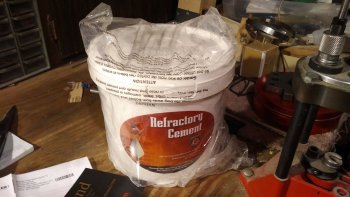That product is a different animal then actual castable refractory. That refractory cement is meant for patch type jobs, where small amounts are used like mortar. That being said, I used that very product as a "slurry coat" over Mizzou 3000 castable when I built my last welding forge. I did use 1" kawool next to the exterior wall, and then poured in 2 1/2" of the Mizzou.
It's not a bad compromise to build a forge with ceramic fiber, covered with a "slurry" of that refractory cement....... by "slurry" I mean A VERY LIGHT COAT! Everybody gets their mind caught up in the "more is better" thing, and tries to put the whole container over the ceramic fiber......that's just counter productive. With that stuff, NO MORE then 1\4" covering the wool. It's ONLY meant to hold the ceramic fibers in place, and has very little insulating/reflecting qualities. If you want additional insulating qualities, go with ITC-100 (expensive), or.....
http://www.hybridburners.com/new-ordering.html (go to the bottom of the page and look at.....
HYB-UV - Infrared reflective coating: I can't tell the difference between it and ITC.....but it's for cheaper.


